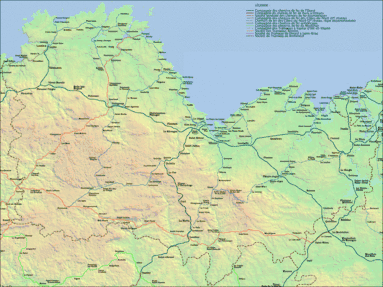Réseau Guerlédan
Réseau Guerlédan was a short-lived railway in Côtes-du-Nord (now Côtes-d'Armor) which operated between 1978 and 1979.
| Réseau Guerlédan | ||||||||||||||||||||||||||
|---|---|---|---|---|---|---|---|---|---|---|---|---|---|---|---|---|---|---|---|---|---|---|---|---|---|---|
| ||||||||||||||||||||||||||

History
The Réseau Guerlédan was 5 kilometres (3.1 mi) in length, laid to a gauge of 12 1⁄4 inches (310 mm), it ran along an abandoned metre gauge trackbed of the Réseau Breton (RB). Statutory powers to operate the line were inherited from the RB because lengths of rail had been left in place where there had formerly been level crossings. With the opening of the line, the Réseau Guerlédan became the smallest (in terms of track gauge) public railway in the world, taking the title from the Romney, Hythe and Dymchurch Railway.[1] A fleet of British built steam locomotives, based on famous narrow gauge designs were produced for use on the line, however only two steam locomotives saw service on the line.
Closure
The reason for the railway's closure was the occupation of the station at Caurel by the local mayor who subsequently let the facility to a member of his family. This seriously compromised the railway operation and as a result, the railway was cut back to terminate one kilometre from Caurel.
There is a myth that the railway was closed after a kidnap attempt on the owner's son and that the operating capital for the following season was employed in effecting his return. However, the son himself has stated that there is no truth in this story.
Locomotives
Four steam locomotives were built in the UK for the railway, all of which survive on the Fairbourne Railway. Only France and Jubilee were shipped to the Réseau Guerlédan - the remaining two were stored.
After closure, Jubilee, France, the Galloping Goose railcar and the rolling stock returned to the UK and were kept in storage until the Ellerton family purchased the Fairbourne Railway in North Wales in 1984. The stock has been in service there ever since.[2] Jubilee was renamed Yeo[3] and France was renamed Sherpa. Odd Job was left in France.
| Image | Name | Builder | Wheel arr. |
Year built | Notes |
|---|---|---|---|---|---|
| France | Milner Engineering | 0-4-0 | 1978 | Model of a Darjeeling Himalayan Railway Class B Tank locomotive, fitted with a tender to accommodate the driver and carry water. Renamed Sherpa at Fairbourne | |
| Jubilee | David Curwen | 2-6-2 | 1978 | Model of Lynton and Barnstaple Railway locomotive, Yeo Renamed at Fairbourne | |
| Galloping Goose | David Curwen | 1978 | Model of Rio Grande Galloping Goose Railcar. Picture | ||
| Odd Job | Small shunting locomotive |
Other locomotives
These locomotives were built for the line, however were never shipped to France.
| Image | Name (Current Name) | Builder | Wheel arr. |
Year built | Notes |
|---|---|---|---|---|---|
 |
David Curwen | David Curwen | 0-6-4 | 1979 | Model of North Wales Narrow Gauge Railways locomotive. Originally named after its builder however on arrival at Fairbourne was renamed Beddgelert. |
| Elaine | Milner Engineering | 2-6-4 | 1979 | Built as a model of a Leek and Manifold locomotive. and named after railway owner, John Ellerton's daughter, however never ran in this form. Rebuilt at Fairbourne into model of Welsh Highland Railway locomotive Russell. |
Rolling stock
The Réseau Guerlédan operated a number of carriages. As of 2011, three of these were located on the 15 in (381 mm) Evesham Vale Light Railway in Warwickshire, United Kingdom.[4]
References
- Hollingsworth, Brian (1982). Railways of the World. London: W H Smith. p. 54. ISBN 0-86124-023-5.
- "History". Fairbourne Railway. Retrieved March 14, 2008.
- "the Fairbourne Railway L&B loco (scale 6" / 1ft)". Lynton & Barnstable. Retrieved March 5, 2008.
- Ashworth, Phil (17 March – 13 April 2011). "Evesham Vale up for sale". Heritage Railway. Horncastle: Mortons Media Ltd (148): 18.
Further reading
- Milner, John (1996). Rails Through the Sand, A definitive History of the Fairbourne Railway. RailRomances. ISBN 1-900622-00-9.